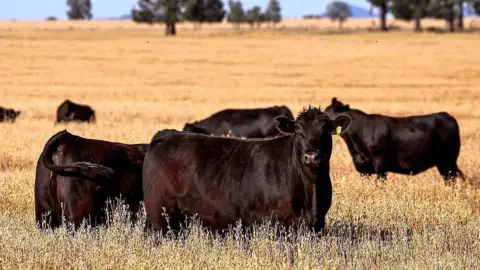Australia’s recent decision to lift the long-standing import ban on beef from the United States marks a significant shift in trade relations between the two countries. This ban, which had been in place since 2003 due to the outbreak of bovine spongiform encephalopathy (BSE)—commonly referred to as mad cow disease—has long been a point of contention, particularly during the Trump administration. The White House pointed to this restriction when justifying tariffs imposed on Australian exports, highlighting the economic and political implications of agricultural policies.
The re-evaluation of this import ban follows a comprehensive analysis conducted by an Australian governmental department, which concluded that the US had made substantial improvements in its beef safety measures over the past decade. Australian authorities stated they became “satisfied” with the US’s capabilities to manage biosecurity threats, which was emphasized by Agriculture Minister Julie Collins, who asserted that the decision was driven solely by scientific assessments. Collins firmly stated, “This decision has been purely based on science,” reinforcing the Albanese Labor government’s commitment to biosecurity without succumbing to external pressures.
However, critics of the decision, including opposition leaders, suggested that the lifting of the ban may have been a concession made to appease former President Trump amid ongoing trade tensions. David Littleproud, the leader of the Nationals party, expressed skepticism regarding the government’s claims of a scientific basis for the decision. He argued that there appeared to be a trade-off involving the biosecurity rules to placate the US administration. This political dynamic reflects the complexity of international trade, especially regarding sensitive issues like animal health and agricultural imports.
Canberra had previously taken steps toward lifting the ban in 2019; however, at that time, beef imports from the US remained practically inaccessible due to the related restrictions on cattle from Mexico and Canada, which obstructed the integration of beef supply chains. Following advancements in cattle traceability protocols implemented by the US, which allow for better monitoring of herds and quicker response in the event of disease outbreaks, Australian officials felt it was finally prudent to reassess the import regulations.
As this decision unfolds, industry leaders express cautious optimism. Will Evans, the chief executive of Cattle Australia, indicated that he felt “comfortable” with the government’s decision, recognizing the importance of the US as a major trading partner for Australian beef exports, which amounted to approximately A$14 billion (around £6.8 billion or $9.2 billion) in the last year. This figure underscores the significance of maintaining healthy trade relations, particularly in the agricultural sector, where the US is Australia’s largest beef export market.
Despite the tensions surrounding Trump’s imposition of “reciprocal” tariffs on Australian goods, a recent report from Meat and Livestock Australia indicates that trade in the beef sector has remained robust. The report noted an increase in trade by about a third within the current year, contradicting fears that tariffs could harm the export market.
In conclusion, Australia’s decision to lift the ban on US beef imports comes amid a complex backdrop of trade negotiations and biosecurity considerations. While the government insists that the decision is based on rigorous science, political overtones remain as opposition leaders question the timing and motivations behind this policy change. The outcome of this decision will likely affect trade dynamics and relationships between Australia and the US in the months ahead, setting the stage for future discussions regarding agricultural policies and biosecurity standards.












